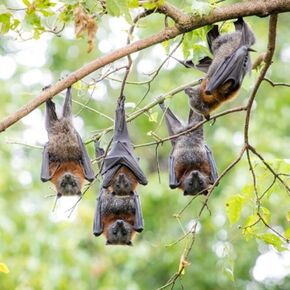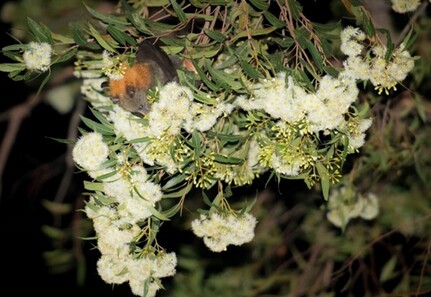Sienna Grady
- MRes Student, Lab of Animal Ecology, Hawkesbury Institute for the Environment, Western Sydney University.
- Topic: Impacts of Australia's recent megafires on the grey-headed flying-fox
- Research Umbrella: Flying-fox movement ecology
- Supervisors: Prof Justin Welbergen, Dr Jessica Meade, Prof Matthias Boer
- Contact: Sienna Grady

Bio:
I completed a Bachelor of Science (Zoology) at Western Sydney University in 2019. Afterwards, I participated in several volunteer programs of bush regeneration until I volunteered for the Lab of Animal Ecology in studying the vocal mimicry of the female Superb Lyrebird in the Blue Mountains. This reinforced my interest in wildlife research, leading me to go back and do a Master of Research at Western Sydney University with the Lab of Animal Ecology in mid-2020.
I completed a Bachelor of Science (Zoology) at Western Sydney University in 2019. Afterwards, I participated in several volunteer programs of bush regeneration until I volunteered for the Lab of Animal Ecology in studying the vocal mimicry of the female Superb Lyrebird in the Blue Mountains. This reinforced my interest in wildlife research, leading me to go back and do a Master of Research at Western Sydney University with the Lab of Animal Ecology in mid-2020.

Research:
The grey-headed flying-fox encounters annual periods of significant food shortage. During the cooler months (April to September), only 20% of food plants flower; therefore, the grey-headed flying-fox is vulnerable to any further reduction in the remaining food habitats, particularly those providing resources during critical times. The Australian 2019/20 ‘Black Summer’ bushfires blazed across forest ecosystems on unprecedented scales, potentially exacerbating such seasonal food shortages.
Broad-scale targeted habitat restoration is urgently needed to fill the gaps in food resource availability across time and space. However, defining key foraging habitats for the grey-headed flying-fox has been challenging due to its extreme mobility in response to highly erratic flowering patterns of its primary food resource, i.e., the nectar and pollen of eucalypt trees.
For my project, I aim to create high-resolution landscape-scale maps of baseline floral resource availability across south-eastern Australia preceding the 2019/20 fires. Then, I will quantify the impact of the 2019/20 fires on pre-fire floral resource areas for the grey-headed flying-fox.
The first part of my project involves the development of a remote sensing-based methodology for high-resolution mapping of flowering canopies of eucalypts. Archival satellite data, along with ground-truthed drone data will allow the creation of baseline maps of floral resource dynamics preceding the 2019/20 fires. These maps will be then validated, using data of the flower-tracking grey-headed flying-fox. Data include location fixes of satellite-tracked individuals and quarterly records of colony abundance.
The second part of my project involves quantifying the extent to which pre-fire floral resource areas for the grey-headed flying-fox were burnt by the 2019/20 fires. This will be done by overlaying fire perimeters and severities onto floral resource areas to obtain an overlap layer. The overlap layer will show the proportion of varying severities of fire-affected floral resource areas.
My project will thus help quantify the impacts of the 2019/20 fires on the floral resource availability for the grey-headed flying-fox, and provide much-needed spatially explicit targets for habitat restoration and conservation to benefit this vulnerable species along with the many other nectarivores that rely on eucalypts as a source of food.
The grey-headed flying-fox encounters annual periods of significant food shortage. During the cooler months (April to September), only 20% of food plants flower; therefore, the grey-headed flying-fox is vulnerable to any further reduction in the remaining food habitats, particularly those providing resources during critical times. The Australian 2019/20 ‘Black Summer’ bushfires blazed across forest ecosystems on unprecedented scales, potentially exacerbating such seasonal food shortages.
Broad-scale targeted habitat restoration is urgently needed to fill the gaps in food resource availability across time and space. However, defining key foraging habitats for the grey-headed flying-fox has been challenging due to its extreme mobility in response to highly erratic flowering patterns of its primary food resource, i.e., the nectar and pollen of eucalypt trees.
For my project, I aim to create high-resolution landscape-scale maps of baseline floral resource availability across south-eastern Australia preceding the 2019/20 fires. Then, I will quantify the impact of the 2019/20 fires on pre-fire floral resource areas for the grey-headed flying-fox.
The first part of my project involves the development of a remote sensing-based methodology for high-resolution mapping of flowering canopies of eucalypts. Archival satellite data, along with ground-truthed drone data will allow the creation of baseline maps of floral resource dynamics preceding the 2019/20 fires. These maps will be then validated, using data of the flower-tracking grey-headed flying-fox. Data include location fixes of satellite-tracked individuals and quarterly records of colony abundance.
The second part of my project involves quantifying the extent to which pre-fire floral resource areas for the grey-headed flying-fox were burnt by the 2019/20 fires. This will be done by overlaying fire perimeters and severities onto floral resource areas to obtain an overlap layer. The overlap layer will show the proportion of varying severities of fire-affected floral resource areas.
My project will thus help quantify the impacts of the 2019/20 fires on the floral resource availability for the grey-headed flying-fox, and provide much-needed spatially explicit targets for habitat restoration and conservation to benefit this vulnerable species along with the many other nectarivores that rely on eucalypts as a source of food.

